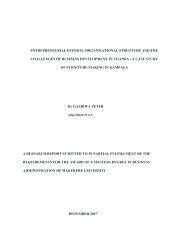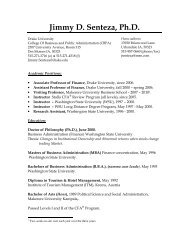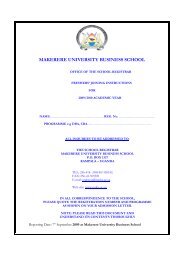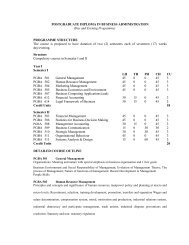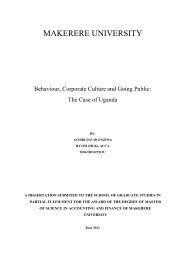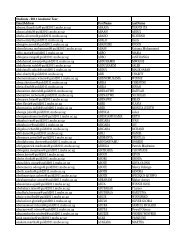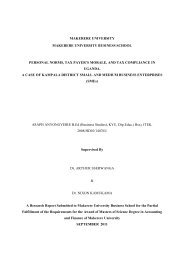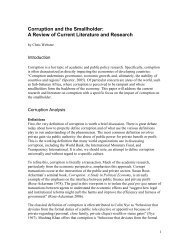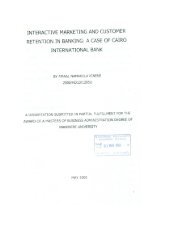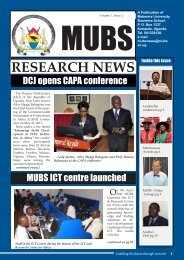13th Annual International Management Conference Proceeding
13th Annual International Management Conference Proceeding
13th Annual International Management Conference Proceeding
You also want an ePaper? Increase the reach of your titles
YUMPU automatically turns print PDFs into web optimized ePapers that Google loves.
Changes were also noted in business management practices in both districts, with participants having introduced<br />
proper record keeping and better farming practices.<br />
Common across participants in the two provinces was production and sale of primary farm produce. However, twelve<br />
of them were involved in merchandising activities such as food groceries, agro-vet, hardware stores and supply of eggs<br />
to supermarkets. One participant in Nakuru District was processing milk into youghurt and making crisps, which she<br />
supplied to schools and retail shops in the neighbourhood. One other participant was running a nineteen (19)-seater<br />
passenger service vehicle (“matatu”), while another had started a private school with the assistance of his retired<br />
mother who worked as a teacher.<br />
Participants in both provinces introduced new business activities and made improvements on existing ones in the form<br />
of new breeds and crops, expansion in scale, crop rotation, intercropping, more employees, value addition and<br />
processing, reinvestments, networking, access to new markets, action planning and record keeping; business-like<br />
approach to farming with Maasais effectively embracing crop farming as a major entrepreneurial activity. However,<br />
none of them had prepared a business plan, though this was covered during the training. Asked to explain why they did<br />
not prepare a business plan to guide their entrepreneurial activities and operations, the respondents indicated that as<br />
much as they appreciated the importance of business planning, they did not fully comprehend how to prepare a<br />
business plan. This was a new concept and perhaps they should have been given an opportunity to prepare one during<br />
the training.<br />
All the participants lauded the training as having been instrumental in the business improvements and changes made.<br />
They particularly pointed out the follow-up, which they said was an element lacking in most training programmes they<br />
had attended before. Knowing that they would be followed up made them apply the KSAs acquired because they<br />
would not want to disappoint the training provider. Appreciating the role of follow-up was two-dimensional: one, it<br />
served as a motivation to implement the training and because the participants knew that there would be follow-up by<br />
the training provider, they worked hard to apply the skills acquired. In addition, they introduced new business<br />
activities as a result of the training. This meets the accountability aspect of training - the worth of the time and funds<br />
spent on training. On the other hand, the appreciation of follow-up confirms what is in the evaluation literature - that<br />
follow-up provides feedback on the quality and quantity of performance (Tosti, 1986).<br />
The content was relevant to the participants’ needs, hence they attributed the many changes and improvements in their<br />
business activities to the training as one participant in Rift Valley Province remarked:<br />
“Before I attended the training, I was not clear on what I was doing. I used to try many things with limited<br />
success. However, from the time I completed the training, I have experienced better yields from my farming<br />
activities. I do farming as a business. I focus on the market and only engage in farming activities, which have<br />
potential for success and high returns. I tell you, my income has since increased tremendously”.<br />
This remark does show that the participants’ expectations were met and that the training had played a major role in<br />
transforming the way in which the participants conducted their entrepreneurial activities: pursuing farming as a<br />
business, something they never did before. They could also gauge when to farm, what farm and when, meaning they do<br />
not engage in farming as a routine, but as an entrepreneurial activity for income generating (agri-business). This<br />
finding was true of the two provinces.<br />
The respondents noted a number of weaknesses in the training programme, such as training sessions being short, with<br />
no provision to practice and discuss the concepts learnt and the training not linked to any credit arrangement to<br />
facilitate effective application of the KSAs acquired.<br />
From the analysis and observations made, there is no doubt that the training had a positive impact on the beneficiaries<br />
and their business activities. The participants in both provinces were able to engage in productive farming and nonfarming<br />
entrepreneurial activities in variety and intensity. The participants were found to have made good use of their<br />
farmlands as seen in the variety of crops grown, the crop rotation systems and use of organic manure processed from<br />
harvest wastes.<br />
All the participants were working more closely with the Extension Officers and other development agencies in their<br />
localities than they did before. They also introduced new business activities and made improvements on existing ones<br />
such as new crops and animal breeds, crops, expanded in scale, practiced crop rotation, intercropping, value addition<br />
96



